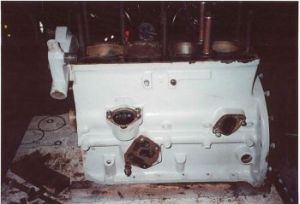 |
 |
 |
 |
 |
 |
 |
 |
 |
 |
 |
 |
 |
 |
 |
 |
 |
|
|
"The Triumph TR engine came from a tractor...."
"The Fergie engine is the same as a Triumph sports car...."
Well neither is quite the case. Here's the story in a nutshell: |
|
|
|
Just after the second world war, Harry Ferguson struck a deal with the Standard Motor Company of Coventry, UK, to manufacture his tractors in space formerly used to build aircraft. Meanwhile Standard was gearing up to produce a "world car", as exporting was key to survival in those days. "Export or expire!" The car would be known as the Vanguard. The Ferguson engine was designed more or less in parallel with the Vanguard engine, and the famous Fergie TEx20 series tractors were manufactured by Standard until 1956 with the engine undergoing various improvements during the production run.
Meanwhile across the street at Banner Lane the Triumph sports car was developed and produced. Its 4 cylinder engine was derived from the Vanguard power plant. The TR2, 3, and 4 models used this engine, and again there were improvements over the years they were produced.
The early Fergies had 80 mm pistons; this was later increased to 85 mm. The early TRs had 83 mm pistons; this was later increased to 86 mm. Fergies operate from 450 to 2000 rpm and the later ones were rated at 28.2 hp. TRs run from about 700-5000 rpm and produce 100 hp.
But - there are similarities, and parts that can be used in either engine. The cylinder sleeves are the same height and the stroke is the same, so an entire set of sleeves, pistons, and connecting rods will fit in either block. The figure-8 gaskets are the same size, although some NOS units I got for the tractor were of a fibrous material whereas the ones for the TR are metal. The main and connecting rod bearings are the same size. I am told the timing chain is the same but haven't tried it - the Fergie has no tensioner though, so I wonder. The head gasket for a TR will fit a Fergie, but not vice-versa as the head studs are a larger diameter on the TR. A water pump kit from a Fergie will work in a TR - but the whole pump does not interchange. (Water pump bearings are the same on both - but are no longer available.) |
|
|
 |
|
|
Block of the Triumph TR3, seen from the left. Notice the opening on the lower right, for the crankcase breather. Just above it is the opening where the fuel pump attaches. (No fuel pump on a Fergie.) |
|
|
 |
|
|
Block of a Fergie TEA20. On this later version (85 mm pistons) the water pump bolts to the head. Notice opening on upper right, where the oil is added. Notice also large opening for the starter motor - on the opposite side from the Triumph. |
|
|
|
The same oil filter head can be bolted to either engine, and the engine serial number is in the same place, just to the right of the ignition coil. |
|
|
 |
|
|
The Fergie engine from above will look very familiar to anyone who has rebuilt a TR engine.
I have bolted on a TR oil filter head so that I could use the readily available spin-on oil filter adapter. |
|
|
 |
|
|
Tractors use governors to keep engine speed constant under varying loads. On the Fergie the governor is activated by the centrifugal force of 4 weights on a bell -shaped piece that fits in the end of the camshaft. Of course none of this applies to a Triumph but I have heard, but not confirmed, that the gear on the crank and the timing chain are interchangable.
The gasket for the timing cover is definitely the same. |
|
|
|
Finally what will be of particular interest to Triumph people, is that on the Fergie engine, the rear oil seal on the crankshaft is the traditional rubber type rather than the scroll type found on the car. |
|
|
|
|
 |
|
|
You don't do this with your Triumph! |
|
|
|
|
|
|

|
|





